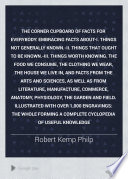 | George William Septimus Piesse - 1858 - 258 pages
...taken. The impression, &c., taken will be the same as the original, but reversed. Fusible metal is a compound of eight parts of bismuth, five of lead, and three of tin, which liquefies at 212°, or the same temperature as boiling water, and below that if one part of quicksilver... | |
 | Robert Kemp Philp - 1859 - 396 pages
...was taken. The impression, &c., taken will be the same as the original but reversed. Fusible metal is a compound of eight parts of bismuth, five of lead, and three of tin, which liquefies at 212 degrees, or the same temperature as boiling water, and below that if one part... | |
 | Sheridan Muspratt - 1860 - 324 pages
...by Sir ISAAC NEWTON, on account of its low melting point, a name which is still retained. A mixture of eight parts of bismuth, five of lead, and three of tin, melts at 202° Fahr., and, according to ROSE, an alloy composed of two parts of bismuth, one of lead,... | |
 | David Page - 1865 - 520 pages
...cable). — Cord-like ; rope-like ; resembling a cord or cable in appearance. Fusible Metal. — An alloy of eight parts of bismuth, five of lead, and three of tin, which melts at the boiling-point of water (212° F.), and may be fused over a candle in a piece of... | |
 | Neil Arnott - 1877 - 916 pages
...at lower temperatures than the metals separately. Common solders are examples. An alloy consisting of eight parts of bismuth, five of lead, and three of tin, melts when thrown into boiling water. It is a kindred fact that in smelting metallic ores in furnaces,... | |
 | Neil Arnott - 1879 - 916 pages
...at lower temperatures than the metals separately. Common solders are examples. An alloy consisting of eight parts of bismuth, five of lead, and three of tin, melts when thrown into boiling water. It is a kindred fact that in smelting metallic ores in furnaces,... | |
 | David Thomas Ansted - 1880 - 300 pages
...these crevices. Another use of bismuth is to reduce the meltingpoint of some alloys. Thus, a mixture of eight parts of bismuth, five of lead, and three of tin produces a metal that melts at a heat a little less than that of boiling water, although none of the... | |
 | Franklin Institute (Philadelphia, Pa.) - 1843 - 442 pages
...assumed the solid form. The alloy experimented on was that known as Newton's fusible metal, composed of eight parts of bismuth, five of lead, and three of tin. On pouring this alloy, in the melted state, on a marble slab, and breaking it as soon as solid, and... | |
 | 1847 - 964 pages
...mineral, is more used at the present day than any of the metals which we have named. It is composed of eight parts of bismuth, five of lead, and three of tin, and this compound is rendered more fusible by the addition of a tenth of mercury; but this addition,... | |
| |